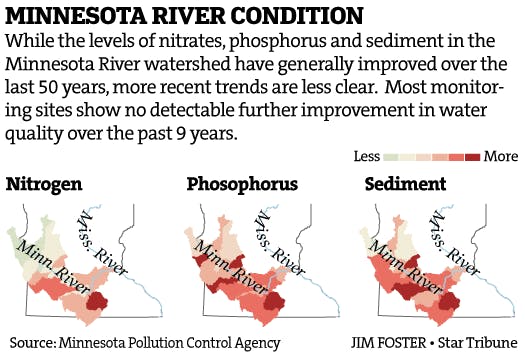The increasing volume of water flowing down the Minnesota River is offsetting slim gains in water quality.
That's the core finding of a new report on the Minnesota River, one of the state's most polluted rivers and one that flows into the Mississippi River in St. Paul. The Minnesota Pollution Control Agency's conclusion is grim: "Sediment clouds the water, phosphorus causes algae, nitrogen poses risks to humans and fish, and bacteria make the water unsafe for swimming."
The agricultural workhorse river has been the focus of intense efforts since the 1970s to improve its water quality; close to $1 billion has been spent on it.
Very long-term trends in nitrates, phosphorus and total suspended solids in the Minnesota River have generally improved, said Lee Ganske, who supervises the PCA's Watershed Pollutant Load Monitoring Network. Recent trends in the watershed are less clear.
"Most sites show no detectable further improvement in water quality over the past nine years," Ganske said.
He said he wished the report showed more signs of progress: "I'm walking that line between concern and optimism."
There have been improvements. Phosphorus flowing into the Minnesota River from wastewater treatment plants, for instance, has dropped 60 percent over the last decade, according to the PCA report out Monday. Phosphorus is a major pollutant that suppresses oxygen in water and contributes to algae blooms.
However, wastewater treatment plants aren't the dominant source of phosphorus in the river. The report blames agricultural chemicals and soil loss from erosion. High levels of nitrates from fertilizer runoff and manure also plague the waterway.
Three large tributaries to the Minnesota River — the Blue Earth, Le Sueur, and Watonwan — show nitrates increasing 60 to 70 percent over the study period, Ganske said. The increases cannot be explained completely, he said, but climate change is suspected to play a role.
Nitrates have tainted Mankato's drinking water, although the city's water is still safe, the study said.
The increasing flow of water down the Minnesota River is driving the water-quality problems. The report blames more and heavier rainfall — a byproduct of climate change — as well as drained wetlands and farmers digging ditches and installing underground tiles to drain water away from fields.
As a result, the flow of the Minnesota River has doubled in the past 80 years. The river actually carries more water per inch of rain than it has historically, the report noted.
The Minnesota River is particularly vulnerable to the swell. A young, flat river, the Minnesota is still cutting through soil, unlike the much older Mississippi River, which has carved down through bedrock creating the scenic gorges that delight tourists.
The larger volumes of water in the river scour increasing amounts of sand from the banks and bottom. The banks of the muddy Minnesota are vulnerable to erosion, with all that silty water scouring the sides and bottom of the river.
"In the entire river valley, 80 percent of the land is used for agriculture, and there have been unintended consequences for the way we developed the land," said Dana Vanderbosch, who supervises the PCA's surface water monitoring unit.
There's been an ongoing push to install more storage basins to address the increased flow of water — the rural version of urban rain gardens. The basins go by various names, such as water retention basins or saturated buffers. Farmers used to call them duck ponds.
They are all part of the overall movement to wetlands restoration to help change the amount and quality of water moving off the landscape while holding back the soil. There's state and federal funding to help farmers install the features, Vanderbosch said, but the features can be expensive to install and obviously take valuable agricultural land out of production.
Ganske said he expects improvements from the state's new buffer law, which requires people with land along public waters and ditches to plant strips of perennial vegetation to stop erosion and polluted runoff.
"It's just starting to kick in," Ganske said. "We may not see the impacts of that in water quality for several years."
Jennifer Bjorhus • 612-673-4683

Records: Former Minneapolis police oversight head disparaged women, threatened staff
Video goes viral of man enduring 'shocking' chain whipping on downtown St. Paul street
Minnesota sales, clean-ups and other events to celebrate Earth Day and Arbor Day

Marijuana's path to legality in Minnesota: A timeline



